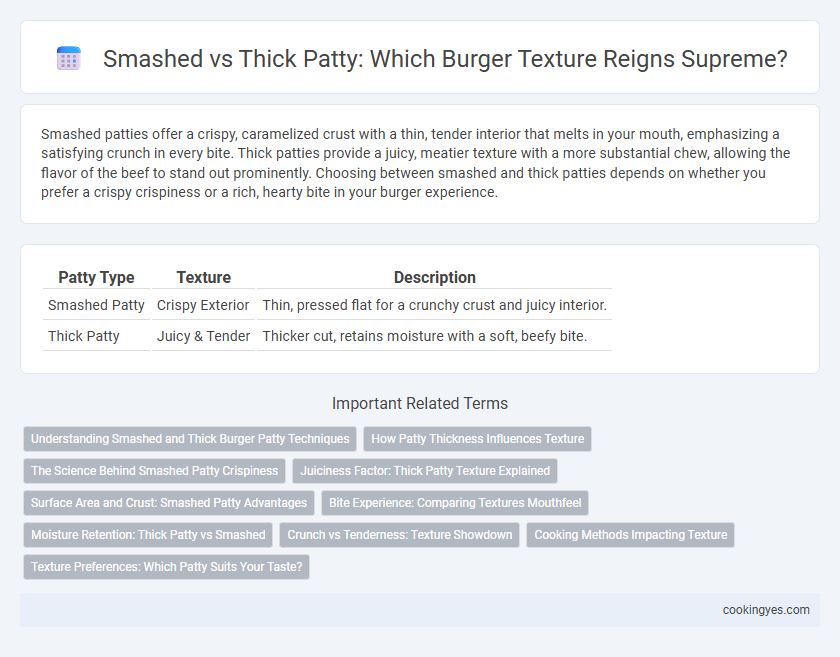Smashed patties offer a crispy, caramelized crust with a thin, tender interior that melts in your mouth, emphasizing a satisfying crunch in every bite. Thick patties provide a juicy, meatier texture with a more substantial chew, allowing the flavor of the beef to stand out prominently. Choosing between smashed and thick patties depends on whether you prefer a crispy crispiness or a rich, hearty bite in your burger experience.
Table of Comparison
| Patty Type | Texture | Description |
|---|---|---|
| Smashed Patty | Crispy Exterior | Thin, pressed flat for a crunchy crust and juicy interior. |
| Thick Patty | Juicy & Tender | Thicker cut, retains moisture with a soft, beefy bite. |
Understanding Smashed and Thick Burger Patty Techniques
Smashed burger patties achieve a crispy outer crust and tender interior by pressing the meat thinly onto a hot griddle, maximizing Maillard reaction for enhanced flavor and texture contrast. Thick burger patties retain juiciness and a more pronounced beefy bite, relying on slower, even cooking to preserve moisture and develop a tender center. Mastering these techniques allows precise control over texture, balancing crustiness and juiciness based on cooking method and patty thickness.
How Patty Thickness Influences Texture
Patty thickness significantly influences burger texture by determining the crust-to-juiciness ratio; smashed patties develop a crispy, caramelized exterior with a tender, thin interior, enhancing crunch and flavor contrast. Thick patties retain more internal moisture, resulting in a juicier, meatier bite with a softer texture and more substantial chew. Texture preference depends on desired mouthfeel, as thinner smashed patties emphasize crispness while thick patties highlight succulence.
The Science Behind Smashed Patty Crispiness
Smashed patties achieve their signature crispiness through the Maillard reaction, where high heat and increased surface contact create a caramelized crust rich in flavor and texture. The thinness of the patty allows moisture to evaporate quickly, preventing steaming and ensuring a crunchy bite. In contrast, thick patties retain more juices but lack the same level of surface caramelization, resulting in a tender rather than crispy texture.
Juiciness Factor: Thick Patty Texture Explained
Thick burger patties retain more juices during cooking, resulting in a moist and tender texture that enhances flavor with every bite. The denser structure prevents rapid moisture loss, creating a satisfying, juicy mouthfeel compared to thinner smashed patties. This juiciness factor makes thick patties ideal for those seeking a rich, succulent burger experience.
Surface Area and Crust: Smashed Patty Advantages
Smashed patties create a larger surface area that enhances the Maillard reaction, resulting in a crispy, flavorful crust that thick patties often lack. The increased crust-to-juice ratio in smashed patties delivers a satisfying texture with a caramelized exterior. This method maximizes browning, providing a distinct contrast between the crunchy surface and tender interior.
Bite Experience: Comparing Textures Mouthfeel
Smashed burger patties offer a crispy, caramelized crust with a thin, crunchy exterior that contrasts their juicy interior, enhancing the initial bite's satisfying crunch. Thick patties provide a dense, tender mouthfeel with a more uniform texture, delivering a meatier, chewier bite that emphasizes savoriness. Choosing between smashed and thick patties depends on whether one prefers a crispy, textured bite or a juicy, substantial mouthfeel in their burger experience.
Moisture Retention: Thick Patty vs Smashed
Thick burger patties excel at moisture retention due to their higher volume, which slows down cooking and preserves juiciness. Smashed patties, with their thin profile, cook quickly and tend to lose more moisture, resulting in a drier texture. The denser interior of thick patties maintains a tender bite, while smashed patties develop a crispy crust that contrasts with their reduced juiciness.
Crunch vs Tenderness: Texture Showdown
Smashed patties create a crispy, crunchy texture on the exterior due to the intense contact with the hot griddle, offering a satisfying bite contrast. Thick patties yield a tender, juicy interior by retaining more moisture during cooking, delivering a soft, succulent mouthfeel. The texture showdown hinges on preference for either the irresistible crunch of thin, smashed patties or the hearty tenderness of thick, juicy burgers.
Cooking Methods Impacting Texture
Smashed patties develop a crispy, caramelized crust due to direct contact with a hot griddle, enhancing texture through intense Maillard reactions. Thick patties retain moisture and juiciness inside, offering a contrast between a seared exterior and a tender, flavorful center because of slower, gentler cooking methods. Choosing between smashed and thick patties depends on desired texture outcomes influenced by cook time, temperature, and surface area exposure.
Texture Preferences: Which Patty Suits Your Taste?
Smashed patties deliver a crispy, caramelized crust with a tender interior, ideal for those who enjoy contrasting textures in every bite. Thick patties offer a juicier, meatier experience with a soft, succulent center that emphasizes the burger's rich, beefy flavor. Texture preferences vary widely, with smashed patties appealing to fans of crunch, while thick patties satisfy those craving a hearty, tender mouthfeel.
Smashed vs Thick Patty for Texture Infographic

 cookingyes.com
cookingyes.com